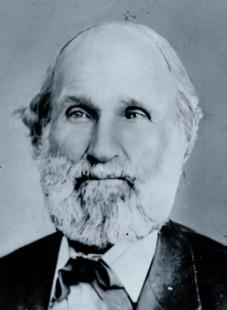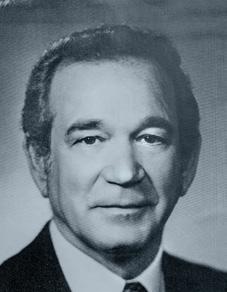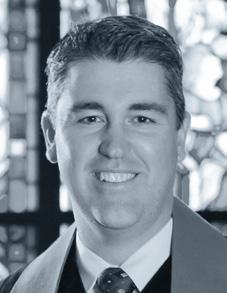
4 minute read
Good shepherds
Eight ministers making a difference
By Joan Williams Hoar
Advertisement
What makes a good pastor? One “job description” outlines the responsibilities of the minister this way:
1) Tell - proclaim the word of God.
2) Teach - provide scripture exposition.
3) Tend - respond to human needs.
The under shepherds, our pastors, must be attuned to the needs of the flock. Or, in the words of Pope Francis, “smell of the sheep,” as he lives among them.
Scripture states, “Be thou diligent to know the state of thy flocks,” Proverbs 27:23. Eight names stand out among the many who understood this, and they are profiled in this story.
The Rev. Robert Loughridge rode horseback from mission outposts to Tulsey Town in 1883 to preach on Sunday, August 19, to a crowd in front of the J.M. Hall store.

First Church, organized on October 5, 1885, with 15 Creek charter members, was served by numerous ministers, but not until Dr. Charles W. Kerr’s pastorage did the congregation have sufficient funding to employ a full-time minister. The Rev. Dr. Kerr began his tenure in January 1900 and oversaw the growth of the Indian Territory congregation from the wooden frame mission school to the current location. During this time, members were instrumental in the founding of numerous community organizations. A 1911 neo-classical Sanctuary at 7th and Boston served until 1925 when the Gothic design Sanctuary was completed. Dr. Kerr served from 1900 until 1941.
Dr. Edmond F. Miller, succeeded Dr. Kerr as pastor on October 1, 1941. The first Christmas Eve “candlelight” service held by any Protestant Church in Tulsa was held in the Sanctuary, the domed neo-classical building razed; and the Kerr Memorial Building dedicated. Dr. Ed Miller retired on March 13, 1956, at which time First Church was the second largest Presbyterian congregation in the United States.


On February 10, 1957, Dr. Bryant W. Kirkland, succeeded Dr. E. Miller as pastor. During his tenure, the church acquired the 39-acre YWCA “Camp Parthenia,” and renamed it “Camp Loughridge.” A 9:30 a.m. Sunday Service was begun and the 11 a.m. service televised. The standing room only crowds necessitated extending the public address system into the Library, Chapel and Junior Auditorium.
Dr. Kirkland resigned in January of 1962 at which time the congregation membership was 5,100. The Dr. William J. Wiseman,Std. succeeded Dr. Kirkland as pastor in May of 1963. During Wiseman's tenure, the church continued participation in the larger community, including the Lent and Advent noon lecture series.

About the author: Joan Williams Hoar is a First Church elder and immediate past historian and chair of the History and Archives Committee. Joan serves as Docent Ministry Committee chair.
During Dr. Wiseman’s pastorage, the chancel area was remodeled, and the Holman Hunt “Light of the World” window was replaced. Wiseman retired in 1984.
Dr. Ernest J. Lewis accepted the call to First Church and served from 1985 to 1991, as senior pastor. During this time the membership rolls were brought up to date. His sermon on commitment to the church resulted in the budget being easily reached.



Dr. James Miller assumed the pastor position in 1992, a position that he still holds today. Dr. Miller’s time has been marked with an increase in community commitment and active role in the international community. A building and renovation maintenance program added needed space for the growth of new programs and services, including a major presence via technology.
Dr. Ryan Moore joined the staff in 2013, left and returned to serve as co-pastor from 2016 to 2019. During Rev. Moore’s tenure, emphasis was placed on programming for young children – our “Little Lambs,” and the fine arts. Ryan is currently senior pastor at First Presbyterian Church in Nashville.

The “roaring lions” that our early pastors dealt with may seem very different from today’s contemporary issues, but the needs continue for the pastor to remain vigilant and aware as they live among us.
And, what is the significance of the number 8? Notice the pulpit and the baptismal font. In religious symbology, eight represents hope and resurrection, our Lenten message.

The First Presbyterian Church of Tulsa Foundation trustees want everyone to be a part of the Foundation and have created a birthday club. In 2023, our goal for every member or friend of the congregation to become a part of the foundation by donating the amount in dollars equal to their age each year. Young and old and in between, we want everyone to celebrate the blessing of life and share blessings with the foundation that will live in perpetuity.
The money raised will be a part of the foundation’s Forward Fund … an integral part of the life of the church which supports programs for everyone from infants to those in homebound care.
The First Presbyterian Tulsa Foundation was established in 1962 with 88 shares of stock and has grown over the last 50 years to an endowment more than $20 million. Every gift to the foundation by a member of our Church is invested and managed by the Foundation Trustees and will grow over time. In the last 25 years, the foundation has distributed more than $11 million to our Church.
It’s easy to join by donating your age online at FirstChurchTulsa.org/Give and select “Make a donation.” Use the pull-down menu to find “Birthday Club” and you’re done. If you drop off or send a check, please note “Foundation Birthday Club” in the memo section. To learn more about the birthday club or the foundation call Katie Williams at 918-292-9063.
About the author:

Katie Williams is a child of the church and currently serving as the Foundation Director for First Presbyterian. She loves to tell your story.
The Sanctuary baptismal font and pulpit both have eight sides. In religious symbology, the number 8 represents hope and resurrection.











